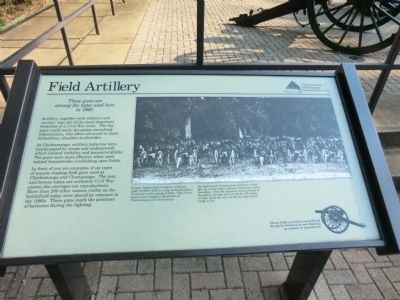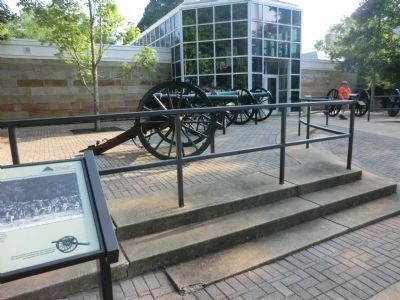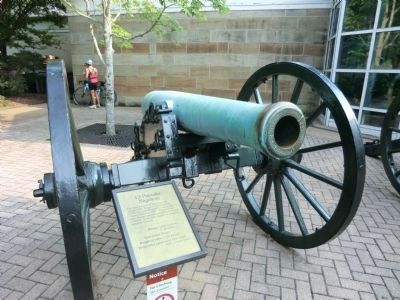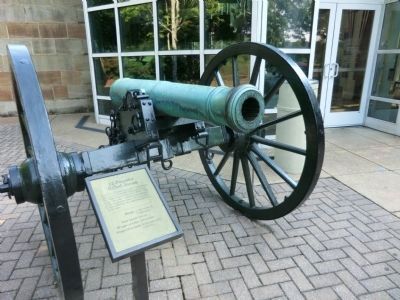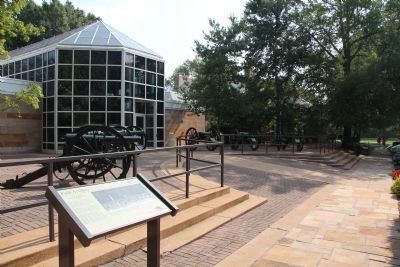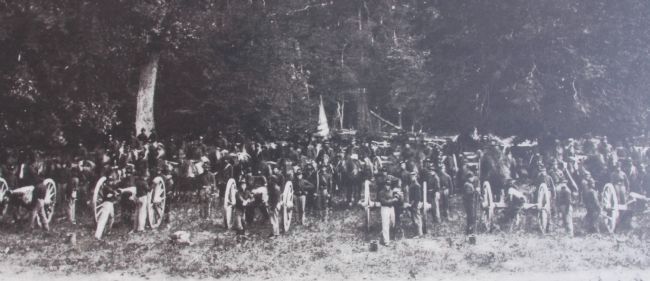Fort Oglethorpe in Catoosa County, Georgia — The American South (South Atlantic)
Field Artillery
Chickamauga and Chattanooga National Military Park
These guns are among the types used here in 1863
Artillery, together with infantry and cavalry was one of the most important branches of a Civil War army. The big guns could easily devastate assaulting infantrymen, who often advanced in mass formations, should-to-shoulder.
At Chickamauga, artillery batteries were handicapped by woods and undergrowth which limited visibility and maneuverability. The guns were most effective when used behind breastworks overlooking open fields.
In front of you are examples of six types of muzzle-loading field guns used at Chickamauga and Chattanooga. The iron and bronze tubes are authentic Civil War pieces; the carriages are reproductions. More than 200 other cannon visible on the battlefield today were placed by veterans in the 1890s. These guns mark the positions of batteries during the fighting.
(caption)
Bridges’ Independent Company of Illinois Light Artillery drills in camp at Murfreesboro, Tennessee, in the spring of 1863. This Union battery later fought in the Battle of Chickamauga and Chattanooga.
An experienced six-man crew could fire a field gun up to four times a minute, following a strict procedure. Note the sequence demonstrated in the photo: the gun crew on the far left begins to load, while the crew on the far right stands ready to fire.
Erected by National Park Service.
Topics. This historical marker is listed in this topic list: War, US Civil. A significant historical year for this entry is 1863.
Location. 34° 56.417′ N, 85° 15.6′ W. Marker is in Fort Oglethorpe, Georgia, in Catoosa County. Marker can be reached from Lafayette Road south of McFarland Gap Road, on the right when traveling south. This marker is located at the Chickamauga and Chattanooga National Military Park Visitor Center. Touch for map. Marker is at or near this postal address: 3356 Lafayette Road, Fort Oglethorpe GA 30742, United States of America. Touch for directions.
Other nearby markers. At least 8 other markers are within walking distance of this marker. Chickamauga and Chattanooga National Military Park (here, next to this marker); The Battle of Chickamauga (a few steps from this marker); Historic Plaques and Markers (a few steps from this marker); Battlefield Monuments (within shouting distance of this marker); 12 - Pounder Mountain Howitzer (within shouting distance of this marker); a different marker also named The Battle of Chickamauga (within shouting distance of this marker); Turchin's Brigade. (within shouting distance of this marker); Warren's Mississippi Light Artillery (within shouting distance of this marker). Touch for a list and map of all markers in Fort Oglethorpe.
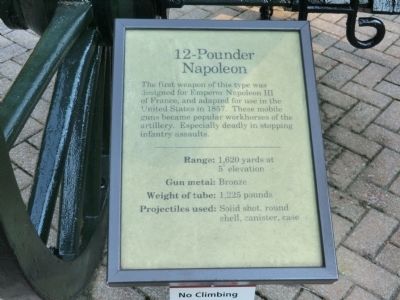
Photographed By Don Morfe, July 28, 2013
3. 12-Pounder Napoleon
The first weapon of this type was designed for Emperor Napoleon III of France, and adapted for use in the United States in 1857. These mobile guns became popular workhorses of the artillery. Especially deadly in stopping infantry assaults.
Range: 1,620 yards at 5° elevation
Gun metal: Bronze
Weight of tube: 1,225 pounds
Projectiles used: Solid shot, round shell, canister, case
Range: 1,620 yards at 5° elevation
Gun metal: Bronze
Weight of tube: 1,225 pounds
Projectiles used: Solid shot, round shell, canister, case
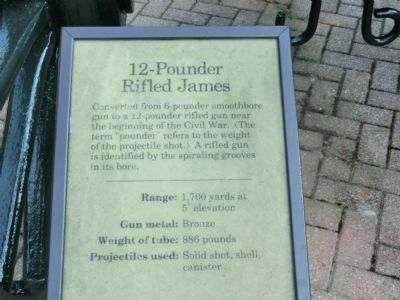
Photographed By Don Morfe, July 28, 2013
5. 12-Pounder Rifled James
Converted from 6-pounder smoothbore gun to a 12-pounder rifled gun near the beginning of the Civil War. (The term "pounder" refers to the weight of the projectile shot. A rifled gun is identified by the spiraling grooves in its bore.
Range: 1,700 yards at 5° elevation
Gun metal: Bronze
Weight of tube: 886 pounds
Projectiles used: Solid shot, shell, canister
Range: 1,700 yards at 5° elevation
Gun metal: Bronze
Weight of tube: 886 pounds
Projectiles used: Solid shot, shell, canister
Credits. This page was last revised on June 16, 2016. It was originally submitted on October 14, 2013, by Don Morfe of Baltimore, Maryland. This page has been viewed 556 times since then and 11 times this year. Photos: 1, 2, 3, 4, 5, 6. submitted on October 14, 2013, by Don Morfe of Baltimore, Maryland. 7, 8. submitted on May 7, 2015, by Dale K. Benington of Toledo, Ohio. • Bernard Fisher was the editor who published this page.
